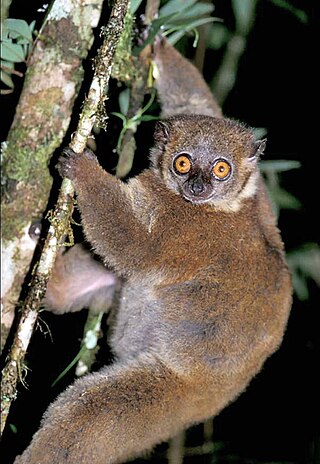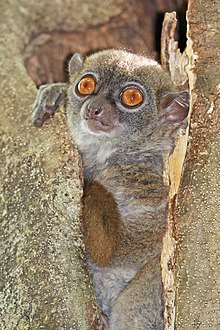
The weasel sportive lemur, also known as the greater sportive lemur, weasel lemur, or greater weasel lemur, is a species of lemur native to northeastern Madagascar. Its habitat includes rainforests and tropical rainforests. Its dorsal side is a reddish-brown colour, and greyish brown ventrally. Its colour darkens towards the tip of its tail. Individuals weigh from 0.8 to 1.2 kg It has long, soft fur. Its body length is approximately 22–30 cm (8.7–11.8 in) and a tail length of 23–27 cm (9.1–10.6 in).

The small-toothed sportive lemur, or small-toothed weasel lemur, is a primate species in the family Lepilemuridae that—like all extant lemurs—is endemic to Madagascar. The species lives in dense rainforest in southeastern Madagascar, and can be found in Ranomafana and Andringitra National Parks. Described in 1894, it was considered either a subspecies or taxonomic synonym of the weasel sportive lemur throughout most of the 20th century. Phylogenetic studies not only support its species status, but also suggest that it is the only eastern Malagasy sportive lemur that is more closely related to western than to other eastern species.

The northern sportive lemur, also known as the Sahafary sportive lemur or northern weasel lemur, is a species of lemur in the family Lepilemuridae. It is endemic to Madagascar. As a result of severe ecological and human pressures, the lemur is classified as Critically Endangered (CR) by the IUCN Red List.

James' sportive lemur, or the Manombo sportive lemur, is a sportive lemur endemic to Madagascar. It is one of the larger sportive lemurs with a total length of about 60 to 67 cm, of which 28 to 32 cm are tail. James' sportive lemur is found in southeastern Madagascar, living in primary and secondary lowland forests.

Wright's sportive lemur, or the Kalambatritra sportive lemur, is a sportive lemur endemic to Madagascar. It is one of the larger sportive lemurs with a total length of about 52 to 64 cm, of which 24–27 cm (9.4–10.6 in) are tail. It is found in southeastern Madagascar, living in primary and secondary mid-altitude forests.

Fleurete's sportive lemur, or the Andohahela sportive lemur, is a sportive lemur endemic to Madagascar. It is a medium-sized sportive lemur with a total length of about 58 to 67 cm, of which about 30 cm (12 in) in are tail Fleurete's sportive lemur is found in southeastern Madagascar, living in primary and secondary rainforests. The lemur was named after Fleurette Andriantsilavo, who was Secretary General of the Ministry of Environment, Water and Forestry in Madagascar.

The betsileo sportive lemur is a sportive lemur endemic to Madagascar. It is a relatively large sportive lemur with a total length of about 58 to 27 cm, of which 32 to 33 cm are tail. The betsileo sportive lemur is found in eastern Madagascar, living in primary and secondary rainforests.

Seal's sportive lemur, or the Anjanaharibe-Sud sportive lemur, is a sportive lemur endemic to Madagascar. It is a large sportive lemur with a total length of about 57 to 64 cm, of which 25 to 28 cm are tail. Seal's sportive lemur is found in northeastern Madagascar, living in primary and secondary mid-altitude rainforests.

Hawks' sportive lemur, also known as the Nosy Be sportive lemur or Nosy Be weasel lemur, is a sportive lemur endemic to Madagascar. Like all members of its genus, it is solitary, nocturnal and largely folivorous. It is threatened by habitat loss and unsustainable hunting.

Grewcock's sportive lemur, or the Anjiamangirana sportive lemur, is a sportive lemur endemic to Madagascar. It is a medium-sized sportive lemurs with a total length of about 55 to 63 cm, of which 26–30 cm (10–12 in) are tail. Grewcock's sportive lemur is found in northwestern Madagascar, living in dry deciduous forests.

Ahmanson's sportive lemur, or the Tsiombikibo sportive lemur, is a sportive lemur endemic to Madagascar. It is a relatively small sportive lemur with a total length of about 47 to 54 cm, of which 23–25 cm (9.1–9.8 in) are tail. Wright's sportive lemur is found in western Madagascar, living in dry forests.

Randrianasolo's sportive lemur, or the Bemaraha sportive lemur, is a sportive lemur endemic to a small area of western Madagascar. It is threatened by habitat loss.

Hubbard's sportive lemur, or the Zombitse sportive lemur, is a sportive lemur endemic to Madagascar. It has total length of about 51 to 59 cm, of which 23–25 cm (9.1–9.8 in) are tail. Hubbard's sportive lemur is found north of the Onilahy River and south of the Mangoky River in Zombitse-Vohibasia National Park in southwestern Madagascar, living in dry transitional forests. The species listed as endangered by the International Union for Conservation of Nature (IUCN) and is threatened by habitat loss and degradation, forest fires, and unsustainable levels of hunting.

Petter's sportive lemur is a sportive lemur endemic to Madagascar. It is one of 26 species in the genus Lepilemur. It is one of the smaller sportive lemurs with a total length of about 49 to 54 cm, of which 22–25 cm (8.7–9.8 in) are tail. Petter's sportive lemur is found in southwestern Madagascar, living in dry spiny forests and some gallery forests.

The Daraina sportive lemur is a sportive lemur endemic to Madagascar. It is a relatively small sportive lemur with a total length of about 49 to 56 cm, of which 24–27 cm (9.4–10.6 in) are tail.

Otto's sportive lemur, or the Ambodimahabibo sportive lemur, is a sportive lemur endemic to Madagascar. Like all members of the genus Lepilemur, it is solitary, nocturnal and largely folivorous. It is threatened by habitat loss and hunting.

Holland's sportive lemur, or the Mananara-Nord sportive lemur, is a sportive lemur that is endemic to Madagascar. It is one of 26 species in the genus Lepilemur. This lemur is found specifically in the Mananara-Nord Biosphere Reserve, but the limits of its habitat have yet to be determined. It lives in primary and secondary rainforests. Holland's sportive lemur was described in 2009.

Lemurs were first classified in 1758 by Carl Linnaeus, and the taxonomy remains controversial today, with approximately 70 to 100 species and subspecies recognized, depending on how the term "species" is defined. Having undergone their own independent evolution on Madagascar, lemurs have diversified to fill many ecological niches normally filled by other types of mammals. They include the smallest primates in the world, and once included some of the largest. Since the arrival of humans approximately 2,000 years ago, lemurs have become restricted to 10% of the island, or approximately 60,000 square kilometers (23,000 sq mi), and many face extinction. Concerns over lemur conservation have affected lemur taxonomy, since distinct species receive increased conservation attention compared to subspecies.
Jean-Jacques Petter (1927-2002) was a French primatologist known for his studies of lemurs and his conservation work in Madagascar.
Edward E. Louis Jr. is an American conservation geneticist who founded the Madagascar Biodiversity Partnership (MBP) in 2010. He is both the Director of Conservation Genetics at Omaha's Henry Doorly Zoo and Aquarium and the General Director of the MBP. Louis attended the Texas A&M University receiving his DVM in 1994 and his Ph.D. in Genetics in 1996.






















